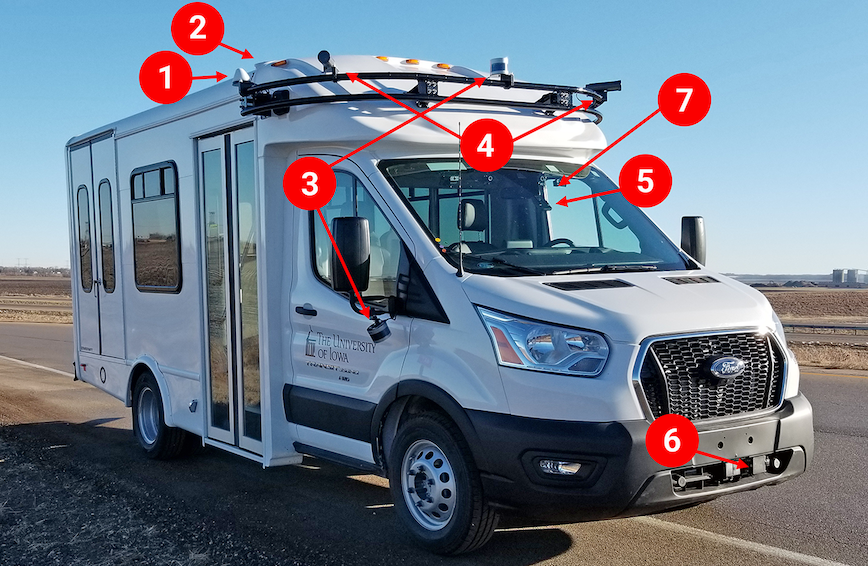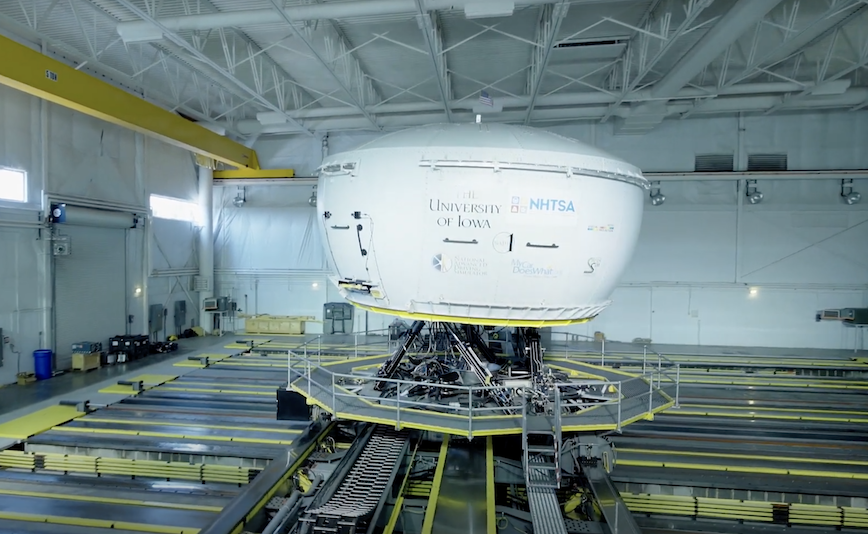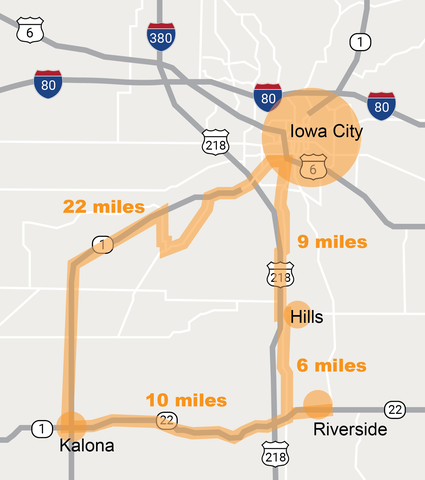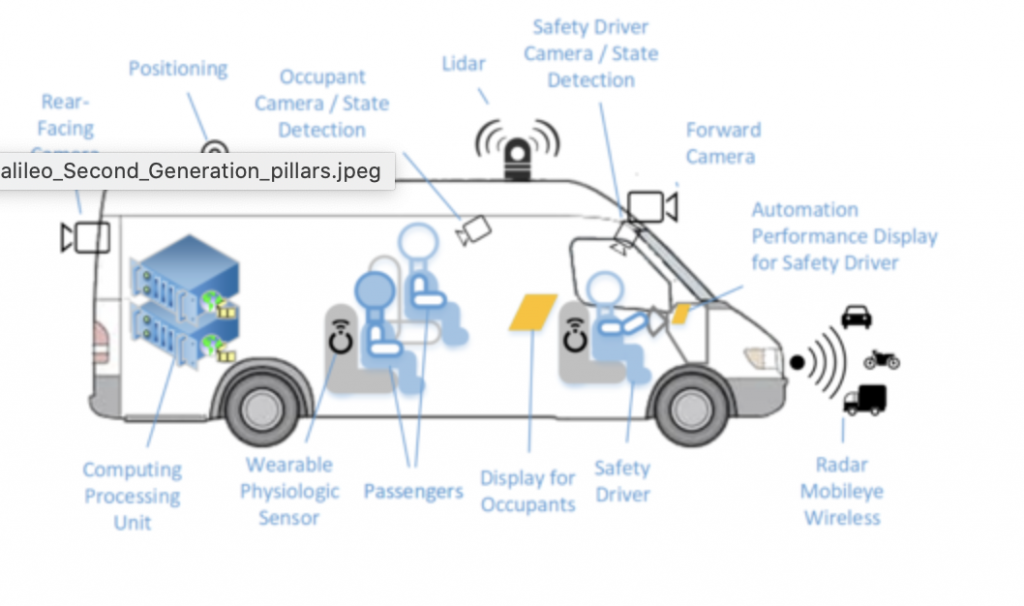The Automated Driving Systems (ADS) for Rural America project, in the form of a Ford Transit 350HD automated shuttle bus, will perform something unique in the fast-developing driverless world. It will collect and publish data not only on vehicle performance but on passenger performance as well. The riders’ physiological data, including stress and anxiety, will be measured, and participants will answer a questionnaire gauging how much they trust the automated vehicle.

In the photo above, each type of vehicle sensor is identified:
- 5.9 GHz Dedicated Short-Range Communications (DSRC) antenna
- GPS antenna: This works to identify the location of our vehicle within a high-definition map of our route.
- LiDARs (Light Detection and Ranging): Multiple LiDARs on the front and rear of the vehicle use scanning laser light to sense the environment around it and detect objects
- High-definition cameras (in waterproof housings): Used to detect traffic light states (color of traffic light) at signaled intersections
- Mobileye 630 collision avoidance system (interior)
- Long range radars: Yet another way to detect objects, radars use radio waves to detect objects.
- Webcam video camera (interior, front and rear)
To help train automated driving software for rural roads, the shuttle outfitted by AutonomouStuff, a Hexagon company, the bus will travel a 47-mile circuit of rural Iowan roads, bringing the benefits of autonomy to populations currently underserved by public transportation options. While only 19% of Americans live in rural areas, rural roads account for 68% of the nation’s total lane miles and 45% of roadway fatalities.
The impressions and reactions of test passengers before, during and after their driverless rides will help guide future driverless implementations across the U.S.
The National Advanced Driving Simulator (NADS) at the University of Iowa oversees the ADS for Rural America project as part of a $7 million research grant awarded by the U.S. Department of Transportation. NADS and Hexagon | AutonomouStuff collaborated to develop the Ford Transit 350HD ADS platform using the PACMod 3.0 drive-by-wire system.

People interested in participating (65 years or older or those 25 and older with a disability that affects their ability to drive) can learn more here.
Mandli Communications will create high-definition maps of the shuttle’s 47-mile route.
A specially trained driver will sit behind the wheel at all times to monitor the automated systems and take control when they’re not in use. Additional researchers will be on board: one as a co-pilot and another or at times several to assist study subjects as the van makes its circuit through Johnson and Washington counties.
The route is a 47-mile loop, driven clockwise, with four stops:

- Iowa City Marketplace (formerly Sycamore Mall)
- Hills Community Center
- Riverside Casino
- Kalona Public Library
Road types include:
- Marked
- Unmarked
- Unpaved
Other variables:
- Will span all four seasons of the year
- Variety of weather conditions
- Different times of day
- Construction areas
The instruments will collect data on how the automated systems perform on different types of roadways, including unmarked and unpaved roads, as well as the effects of varying weather conditions, times of day, and navigating unique traffic situations like farming equipment, construction zones, and football game days in Iowa City.
Researchers will study the passengers: rural residents ages 65 and older or people with a disability that affects their ability to drive. Over the course of two years and 80 drives, hundreds of terabytes of data will be collected and made available for public analysis by other research institutions, government, and industry.
Video screens inside the vehicle will show passengers their estimated arrival time, current weather conditions, and possibly more. “If you were a passenger, what kind of information would make you feel better or have more trust in the vehicle?” rhetorically asked Omar Ahmad, project manager and NADS deputy director.

NADS has studied how humans interact with their vehicles since 1992, when the National Science Foundation and the National Highway Traffic Safety Administration selected Iowa to host the center. Many now-standard crash avoidance features were first tested there, and today NADS is a vital focus point of advanced automotive driving research.
“When we look at automated vehicles, it’s clear there’s an over-emphasis on urban areas and interstates,” added Ahmad. “Until now the focus has been on perfect roads in perfect weather—we will examine the challenges of rural environments, which are often imperfect.”
The project envisions that people who are uncomfortable driving or unable to drive will be able to summon vehicles to their homes for rides to the grocery store or doctor’s office. “It could make something that causes a lot of anxiety and planning go really smoothly,” Ahmad says. “In fact, it could even encourage people to move out more into rural areas instead of having to live in urban areas where the services are.”
The roads along the route through represent the types of scenarios that automated vehicles will regularly encounter beyond city borders: inconsistent lane markings and surface conditions; great disparities in the speed and type of vehicles using the roadway; and inclement weather, including heavy snow that obscures paved surfaces. Outside Kalona, motorists share the road with horse-drawn carriages from a nearby Amish community.
“Automated vehicles should work just as well on these types of roadways as in cities and on interstates,” Ahmad stated.
“We’re very interested in [passengers’] trust and acceptance before, during and after being in a vehicle like this,” Ahmad concluded. “There’s going to be a range of opinions and pre-conceived notions of what these vehicles are and what they mean — and we need to understand that better.”

